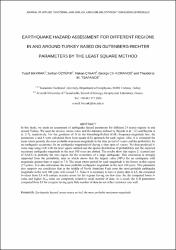Earthquake hazard assessment for different regions in and around Turkey based on Gutenberg-Richter parameters by the Least Square Method

View/
Access
info:eu-repo/semantics/openAccessDate
2009Access
info:eu-repo/semantics/openAccessMetadata
Show full item recordAbstract
In this study, we made an assessment of earthquake hazard parameters for different 24 source regions in and around Turkey. We used the seismic source zones and the database defined by Bayrak et al. [12] and Bayrak et al. [17], respectively. For the goodness of fit to the Gutenberg-Richter (G-R) frequency-magnitude law, the parameters a and b were calculated from least square (LS) approach for each region. Also, it is estimated the mean return periods, the most probable maximum magnitude in the time period of t-years and the probability for an earthquake occurrence for an earthquake magnitude?M during a time span of t-years. We then produced bvalue map using G-R with the least square method and the spatial distribution of probabilities and the expected maximum earthquake magnitude in the next 100 years are plotted. The results show that region 21 (central part of NAFZ) is probably the next region for the occurrence of a large earthquake. This conclusion is strongly supported from the probability map in which shows that the largest value (98%) for an earthquake with magnitude greater than or equal to 7.0. The mean return period for such magnitude is the lowest in this region (27-years). It is also determined the most probable earthquake magnitude in the next 100 years. This parameter also supports our conclusion that in the middle of North Anatolian Fault zone the most probable earthquake magnitude in the next 100 years will exceed 7.5. Since it is necessary to have a plenty data in LS, the computed b-values from LS will contain extreme errors for the regions having too few data. So, the computed lower bvalue and higher M100 value are completely related to small number of data. As a result, the G-R parameters computed from LS for a region having quite little number of data do not reflect tectonics very well.

















